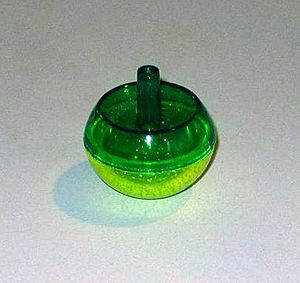Tippe top facts for kids
A tippe top is a super cool toy that looks like a regular top, but it does something amazing! When you spin it really fast, it flips itself upside down and keeps spinning on its tiny stem. It's like magic, but it's actually all about physics!
Contents
What is a Tippe Top?
A tippe top usually looks like a ball with the very top cut off, making it a bit flat. It has a short, thin stick, or "stem," right in the middle of this flat part. You can use this stem to pick up the top. It's also how you get the top spinning!
How Does it Flip?
When you spin a tippe top really fast, its stem slowly starts to tilt down. It keeps tilting until, suddenly, the whole top lifts its main body off the ground! The stem then points downwards, and the top spins on it.
As the top spins slower and slower, it eventually loses its balance. Just like any other spinning top, it will then fall over.
Energy and the Flipping Top
When the top flips over, it might look like it's gaining energy. This is because its center of mass (the average place where all its weight is) actually moves higher up. Moving something higher usually means it gains potential energy.
But don't worry, the top isn't breaking any rules of physics! The flip happens because of friction between the top and the surface it's spinning on. This friction creates a special push, called a torque, that makes the top flip. While the potential energy goes up, the top's spinning energy (called kinetic energy) goes down. So, the total energy stays the same.
Spinning Direction
Here's another cool fact: when the top flips, it doesn't change the direction it's spinning! If you spun it clockwise, it will still be spinning clockwise even after it's upside down on its stem. This happens because of something called the conservation of angular momentum. It's a rule in physics that says the "spinning power" of an object tends to stay the same unless something outside acts on it.
The Science Behind the Flip
For a long time, scientists have studied why tippe tops behave this way. It's a bit tricky to explain fully, but the main idea is that the friction between the top and the surface is super important.
Scientists have found that the way the top rubs against the ground (the "dry friction forces") is what makes it flip. Without this friction, the tippe top wouldn't be able to do its amazing upside-down trick!


